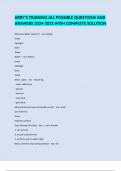Samenvatting
Summary of lectures and knowledge clips Food Ingrdient Functionality (FIF) FCH-30306
This summary contains all lectures and knowledge clips. With a very nice overview of all the polysaccharides in a table, help me a lot with learning all the content.
[Meer zien]













